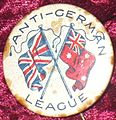Anti-German sentiment facts for kids
Anti-German sentiment (Germanophobia or Teutophobia) is an opposition to, or fear of, Germany, Germans, its culture and the German language. The opposite is called Germanophilia.
The sentiment began with the mid-19th century unification of Germany, which made the new nation a rival to the Great powers of Europe in economics, military, cultural, and geopolitical grounds. It was believed correctly in other countries that Otto von Bismarck and Helmuth von Moltke were driving Germany towards domination of the European landmass. Bismark unified Germany in 1871 and was their first Chancellor, serving until 1890.
Von Moltke the elder was chief of staff of the Prussian Army for 30 years. He commanded in the Austro-Prussian War and the Franco-Prussian War. He is described as a "Prussian military organization and tactical genius". He was fascinated with railways and pioneered their military usage. He is often referred to as Moltke the Elder to distinguish him from his nephew Helmuth Johann Ludwig von Moltke, who commanded the German Army (Deutsches Heer) at the outbreak of World War I.
Images for kids
-
Anti-German cartoon from Australia, Norman Lindsay, between 1914 and 1918
-
German shelling of Reims Cathedral in France early in the First World War
-
A 1917 comic strip in which the character smashes a clown doll present because it was made in Germany
See also
 In Spanish: Antigermanismo para niños
In Spanish: Antigermanismo para niños









